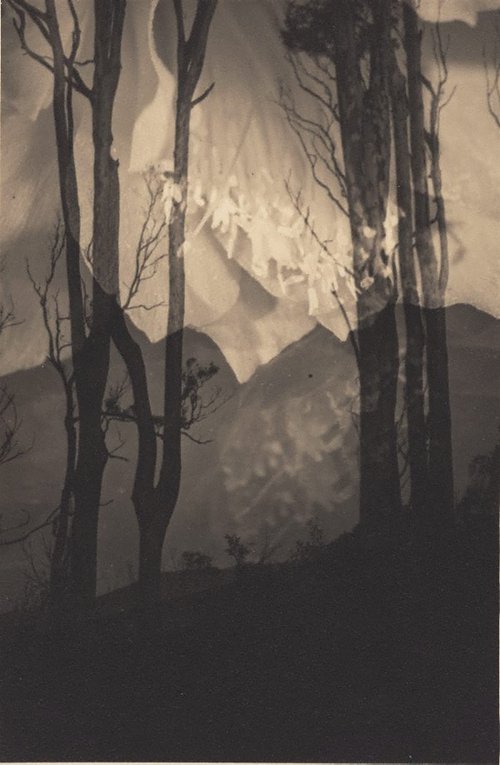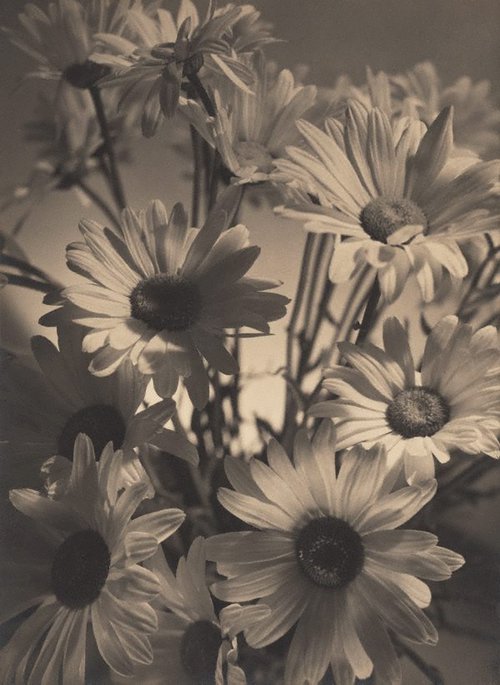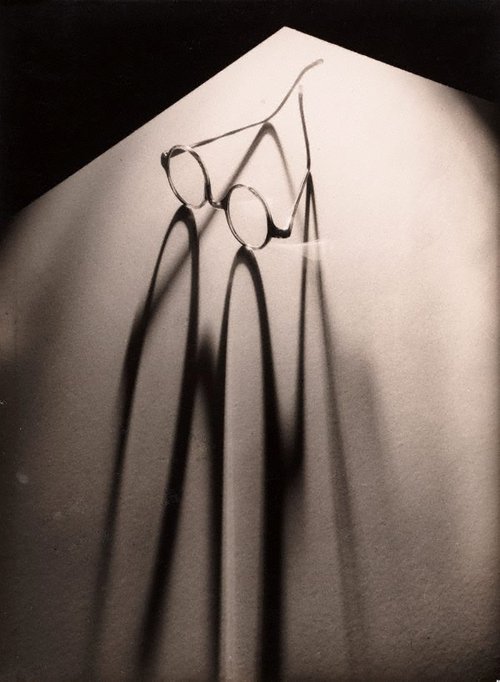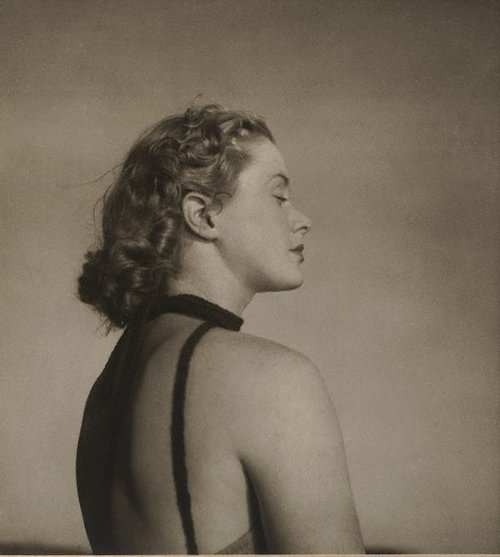-
Details
- Date
- circa 1935
- Media category
- Photograph
- Materials used
- gelatin silver photograph
- Dimensions
- 37.3 x 29.6 cm image; 38.0 x 30.2 cm sheet
- Signature & date
Signed l.r. sheet., pencil "Olive Cotton". Not dated.
- Credit
- Gift of the artist 1980
- Location
- Not on display
- Accession number
- 218.1980
- Copyright
- Artist information
-
Olive Cotton
Works in the collection
- Share
-
-
About
'This picture evolved after I had bought some inexpensive cups and saucers from Woolworths for our studio coffee breaks to replace our rather worn old mugs. The angular handles reminded me of arms akimbo, and that led to the idea of making a photograph to express a dance theme.
When the day’s work was over I tried several arrangements of the cups and saucers to convey this idea, without success, until I used a spotlight and realised how important the shadows were. Using the studio camera, which had a 6 ½ x 4 ½ inch ground glass focusing screen, I moved the cups about until they and their shadows made a ballet-like composition and then photographed them on a cut film negative. The title of the photograph suggested itself.
This was my first photograph to be shown overseas, being exhibited, to my delight, in the London Salon of Photography in 1935.' Olive Cotton 1995 1
Olive Cotton and Max Dupain were childhood friends and, although she graduated in English and mathematics from the University of Sydney in 1934, her interest in photography led her to work in Dupain’s studio from this year. Cotton was employed as a photographer’s assistant in the studio, however she worked assiduously on her own work and continued to exhibit in photography salon exhibitions. ‘Tea cup ballet’ is one of Cotton’s most well-known photographs and yet it is somewhat eccentric to her main practice, being at first glance typically modernist with its dramatic lighting and angular shapes. Her longstanding interest in organic forms provides a deeper reading. The abstraction of form by the lighting and the placement of the cups and saucers enables the relationship to dancers on a stage to become clear.
1. Ennis H 1995, ‘Olive Cotton: photographer’, National Library of Australia, Canberra p 25
© Art Gallery of New South Wales Photography Collection Handbook, 2007
-
Exhibition history
Shown in 11 exhibitions
Seeing is believing - the art in photography, Art Gallery of New South Wales, Sydney, 13 Dec 1985–19 Jan 1986
Shades of Light, National Gallery of Australia, Canberra, 1988–1988
Works from the Photography Collection, Art Gallery of New South Wales, Sydney, 10 Feb 1989–15 May 1989
In a certain light: Clarice Beckett and Olive Cotton, Ivan Dougherty Gallery, Paddington, 08 Mar 1995–15 Apr 1995
Review: works by women from the permanent collection of the Art Gallery of New South Wales, Art Gallery of New South Wales, Sydney, 08 Mar 1995–04 Jun 1995
Olive Cotton, Art Gallery of New South Wales, Sydney, 13 May 2000–02 Jul 2000
Olive Cotton, National Library of Australia, Canberra, 14 Jul 2000–08 Oct 2000
Soft Shadows and Sharp Lines: Australian photography from Cazneaux to Dupain, Art Gallery of New South Wales, Sydney, 30 Sep 2002–17 Nov 2002
Great collections (2009), Campbelltown Arts Centre, Campbelltown, 12 Dec 2008–18 Jan 2009
Great collections (2009), Tweed Regional Gallery & Margaret Olley Art Centre, Murwillumbah, 06 Feb 2009–15 Mar 2009
Sydney Moderns, Art Gallery of New South Wales, Sydney, 06 Jul 2013–07 Oct 2013
Call of the Avant-Garde: Constructivism and Australian Art, Heide Museum of Modern Art, Melbourne, 05 Jul 2017–08 Oct 2017
20th-Century galleries, ground level (rehang), Art Gallery of New South Wales, Sydney, 20 Aug 2022–2023
-
Bibliography
Referenced in 12 publications
-
Judy Annear, Photography: Art Gallery of New South Wales Collection, 'Australian modernism', pg.131-149, Sydney, 2007, 137, 141 (illus.).
-
Natasha Bullock (Curator), Soft shadows and sharp lines: Australian photography from Cazneaux to Dupain, Sydney, 2002. no pagination or catalogue numbers
-
Edmund Capon, Olive Cotton, 'Foreward', pg.4, Sydney, 2000, 4, 16, 20, 22, 24 (illus.). cat.no. 7
-
Deborah Edwards, Daphne Wallace, Margo Neale, Victoria Lynn and Sandra Byron, Review: works by women from the permanent collection of the Art Gallery of New South Wales, The Photography Collection, Sydney, 1995, 17 (illus.).
-
Deborah Edwards, Sydney moderns: art for a new world, 'Ultra-moderne: 'Implement blue' and 'The Lacquer Room'', pg.148-153, Sydney, 2013, 152 (illus.), 184, 203.
-
Janet Hawley, Artists in conversation, 'Olive Cotton', pg. 394-403, Richmond, 2012, xxiv (colour illus.), 395, 398, 399, 400, 401.
-
Bruce James, Art Gallery of New South Wales handbook, 'Australian Collection: Australian Photography', pg. 198-207, Sydney, 1999, 203 (illus.).
-
Josef Lebovic Gallery and Helen Ennis, Masterpieces of Australian Photography, Twentieth Century Photography, Sydney, 1989, 142, 143 (illus.). cat.no. 246
-
Ewen McDonald, AGNSW Collections, 'From Colonialism to late Modernism', pg. 7-106, Sydney, 1994, 39 (illus.).
-
John McPhee, Great collections, Sydney, 2008, 100 (colour illus.).
-
Gael Newton, Australian Art Review, 'Photography, Towards a dialogue with other media', p42-46, Rozelle, 1982, 43 (illus.).
-
Ursula Prunster, Seeing is believing: the art in photography, Sydney, 1985. cat.no. 12
-




